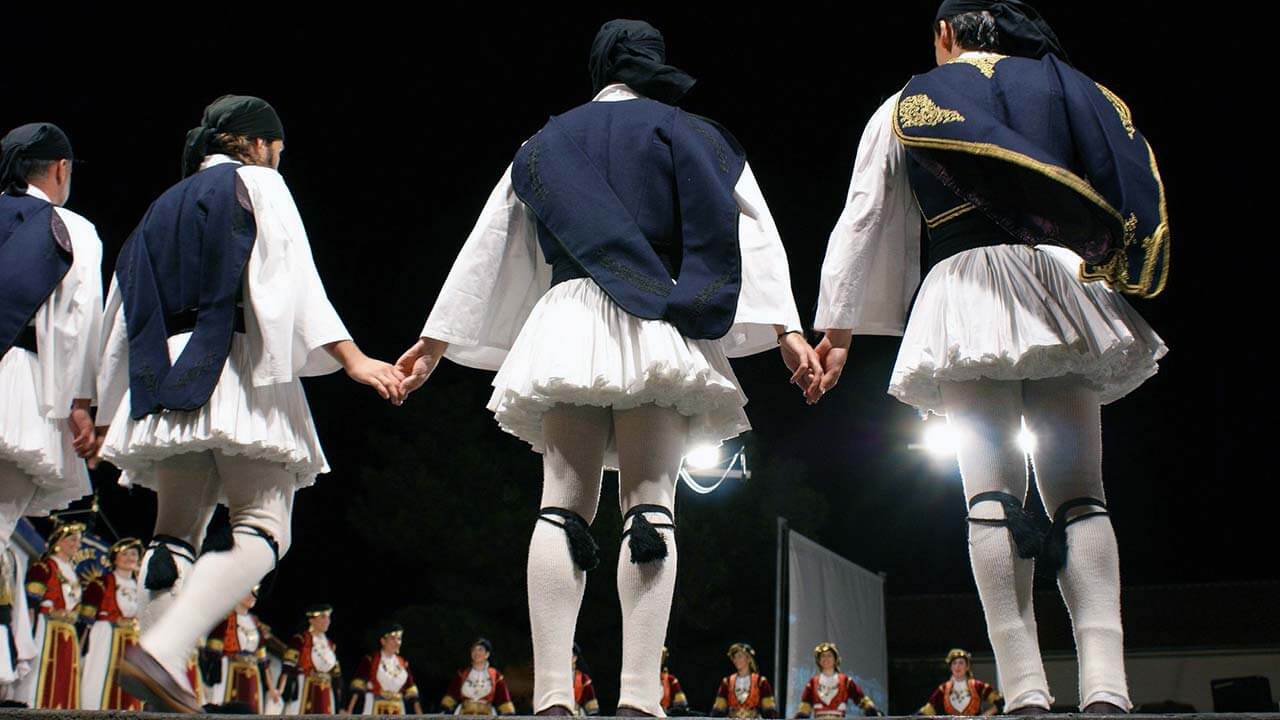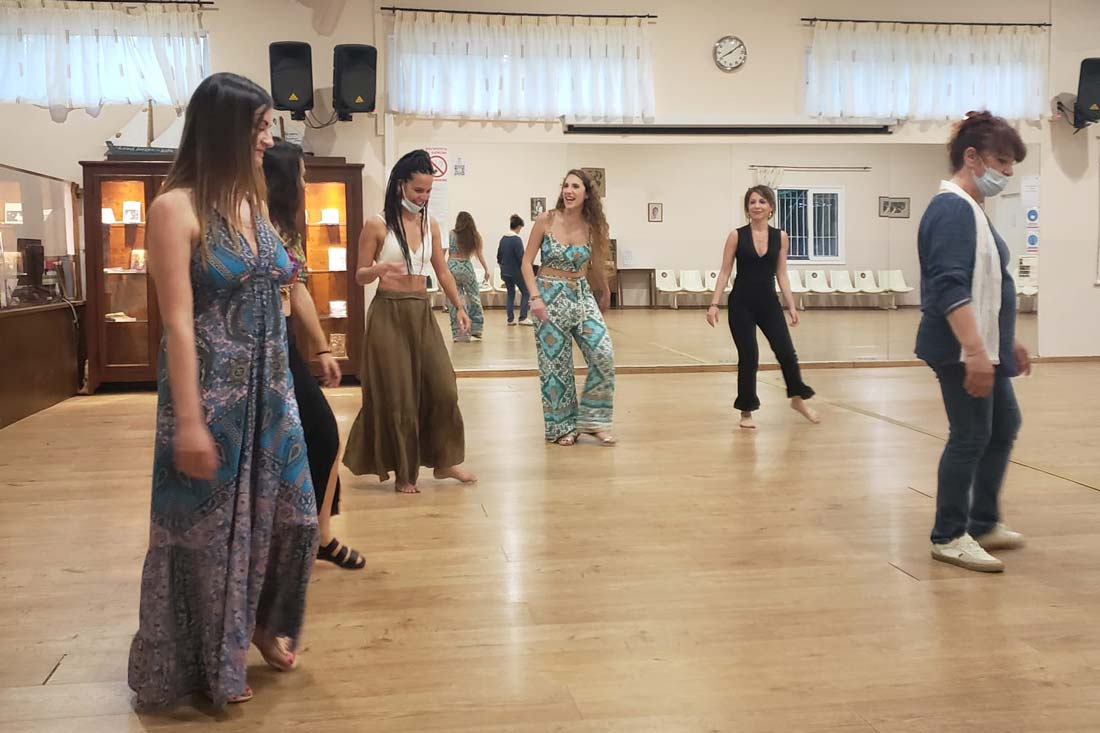1. Sirtaki
Sirtaki (also called syrtaki) is arguably the most famous Greek dance to the non-Greeks. It owes its reputation to the movie “Zorba the Greek” (1964) with Anthony Quinn. The eminent Greek composer Mikis Theodorakis created this dance by alternating slow and fast steps of two famous Greek dances, Hasapiko and Hasaposerviko. Thus, Sirtaki was born and took its baby steps on the big screen! The rest is history… Today, it is one of the most famous and fun Greek folk dances, raising the spirits every time. To dance it, place your arms on your neighbors’ shoulders and form a line or a circle.
2. Ikariotikos
Definitely one of the most beloved dances in Greece, Ikariotikos is a very exciting and fun dance. It is part of the “Nisiotika”, the dances that come from the Greek islands (‘nisi’ means ‘island’ in Greek), and specifically from the island of Ikaria. The dance has three different stages. It starts with a slow pace, then moves to the second stage where the pace quickens. Finally, in the third stage, the pace becomes even faster and everyone needs to move in complete synchrony in order to manage the dance. The faster the pace, the more fun it is, so it is not surprising that this is one of the most famous Greek traditional dances. It is performed in a line or a circle and the dances hold hands at shoulder height.
3. Kalamatianos
Another very popular folk dance in Greece. It derives its name from Kalamata, the city of the Peloponnese peninsula. Nevertheless, it is well-known all over Greece and is established as a Pan-Hellenic traditional dance. Kalamatianos dance is also performed in a line or a circle, with dancers holding hands. Its roots can be traced in Greek antiquity, all the way back to Homer!
4. Hasapiko
Mikis’ inspiration for creating the Sirtaki. Hasapiko is a traditional Greek dance that has its roots in the city of Constantinople. Its history goes all the way back to the Middle Ages when butchers performed battle dances with swords. Thus, the name of the dance (‘hasapis’ means ‘butcher’ in Greek). Just like the Sirtaki, Hasapiko is performed in a line or a circle, with the dancers placing their arms on their neighbors’ shoulders. Hasapiko progresses from a slow to a faster pace. The faster-paced version is called Hasaposerviko.
Hint! Are you visiting Greece and Athens soon? Take the opportunity and enjoy a Greek dance lesson at the heart of the city, from a qualified teacher! Dance your heart out and learn all about the spirit of the Greek dances by experiencing it yourself.
5. Tsamiko
This Greek fold dance has been characterized as Pan-Hellenic, although it isn’t popular in the Greek islands. Its roots are traced in the movement of the ‘Klefths’ during the Greek Revolution in the early 19th century. The Klefths were anti-Ottoman, warlike mountain-folk who lived in the countryside when Greece was a part of the Ottoman Empire. Originally, only men performed this dance. Today, women join as well. When this happens, it usually includes a ‘double banister’, with men dancing in the outer circle and women in the inner. Alternatively, there is one circle with one male dancer followed by a female and so on. Tsamiko can be danced by the whole group (that is, everyone performs the same steps-movements) but also individually, where the first dancer does a solo, improvising and expressing himself.
6. Pentozali
The Pentozali is a very enthusiastic, war dance. It is the dance of revolution. Directly connected with the history of Crete and its people's liberation fight. Nothing in this dance is accidental. Every part (from the music to every step of the dance) is symbolic of their fight for freedom. It is danced in a line, with the lead dancer performing various moves, while the other dancers follow with the basic steps.
7. Sousta
Another Cretan dance, Sousta is another very famous traditional Greek dance, now being performed all over Greece. It is a love dance, with the man and woman dancing facing each other. First, the dance begins in a circle with a hand grip from the palms and the elbows bent. Then, the circle begins to dissolve and the two opposite scales come face to face. Sousta seems to be the ancient dance that was called "Pyrrhichios" but with the entry of women into the dance, its nature changed and from warlike it became purely erotic. The dance consists of small steps that are done on the spot or moving slightly forward, backward, right and left, with the addition of side steps and other variations. Two good dancers can easily perform a love story from the beginning to the end.
8. Zeibekiko
This is a dance completely different from the above. This is performed by one dancer at a time and it does not exactly have specific steps to follow. It is a free dance and it depends on the character of each dancer. Improvisation is a valuable skill here and, although slow in pace, it has a strong intensity. It used to be a dance for men only but today everyone can dance to it. Each dancer has his own figures with which he expresses himself. Also, each dancer dances to only one song, only once. Many times it is his own, specific song and not a random one. Traditionally (and this remains a strong custom in some areas of Greece even today), when someone is dancing no one else is allowed to interrupt or disturb him, or dance with him in the same place.
Hint! If you are visiting Athens any time soon, book a Greek dance lesson and learn how to dance some of the above Greek dances.
About the author: Our team at Greek TravelTellers consists of academics and lovers of Greek culture. Our vision is to convey our knowledge and Greek values through unique tours and experiences. Through our blog, we hope to bring Greek history and culture closer to you. Feel free to learn more about us.




